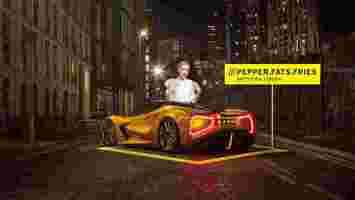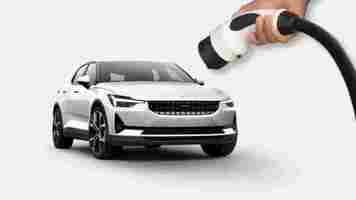Lotus’ $2.8M supercar is getting super accurate navigation to help rich people find their way
British sports car maker Lotus is adding navigation tech from What3words to give drivers another option to find their way to their destination. It’s starting by putting it in its $2.8 million (£2 million) all-electric supercar, the Evija.

Lotus is integrating What3words’ word-based navigation tool into its app, which will allow drivers to set a 3×3 meter square piece of earth as their destination. The app will then take care of routing and navigation, and the car will display turn-by-turn instructions on their instrument cluster.
I guess super rich people aren’t wealthy because they always know how to get to where they’re going, huh.
As brilliant as satellite navigation systems are, they aren’t perfect. Sometimes they guide you down roads that no longer exist, or won’t know what’s going on if you travel down new roads. Many will also be aware of how painful it can be navigating to post codes that cover large geographical areas.
What3words however, takes a unique approach to solving these problems. The navigation and mapping app has split the world up into 3×3 meter squares, and then labeled each with a three word name.


This means navigating to the middle of nowhere, with no address, is as easy as putting in the three words, and letting the route planner section of the app do the rest.
While Lotus is putting the tech in its hyper expensive, all-electric supercar, first, it’s also going to bring the functionality to the rest of its vehicles starting from this year.
So it’s not just going to be a toy of the rich, some regular folk might actually get a chance to use this too. And well, if you don’t drive a Lotus, you can always just download the regular What3words app, and pretend.
Do EVs excite your electrons? Do ebikes get your wheels spinning? Do self-driving cars get you all charged up?
Then you need the weekly SHIFT newsletter in your life. Click here to sign up .
Why your EV’s range matters less than you think
How often do you think the average car owner drives long distances? For that matter, how often do you drive long distances? Most likely, the answer is a few times a year maybe when you’re going on holiday or to visit family.

People on average use their cars daily to get to work, for social calls, and to run errands. It’s rare that any of these tasks will take you farther than 60 kilometers from your home. With new electric vehicle models like the Polestar 2 that have a range of 400 to 500 kilometers per charge, why is running out of fuel still a concern for prospective EV buyers?
We need to dispense with the idea of range anxiety. It’s just one of those EV myths that doesn’t serve anyone because it has already been debunked . People never had such anxieties about ICE vehicles, due to the ease of refueling at petrol stations. But for the average car driver who uses their car for commutes and shopping, what is more convenient than plugging in your EV every time it’s parked, which is the majority of the time, or at home while you sleep?
What is range anxiety?
Range anxiety is the amped up worry or fear of something in the future that has not yet, and likely will not, come to pass. That specific something in this case is being stranded somewhere with a dead battery and a useless car.
For the range-anxious, thoughts usually go something like this: “I’m going somewhere new. What if there are no public charging stations that I can use?” or “What if I find a charging station but it’s poorly maintained and I don’t have enough range to get to another one?”
This is nothing but fear of the unfamiliar. These aren’t thought processes that usually occur to people driving internal combustion engine vehicles, and it shouldn’t be going through the mind of prospective EV owners, either.
How far can EVs go?
Again, most EVs on the market today can go up to 400 to 500 kilometers on just one charge. Based on the way the average European driver uses their car, most people will charge their vehicles only once a week! The process of charging your EV will likely take much less effort than refueling a conventional car because you don’t wait until it’s empty to fill up the electric tank. You just top up whenever the car is parked, which again, is all the time! Depending on the type of charger you’re using, charging can take as little as 40 minutes, or as much as eight hours. You can calculate how long your charge is likely to take with online tools like Polestar’s range calculator .
Finding public or private charging stations is easier than you think
Charging stations are cropping up all over. You can find them in supermarket parking lots, near the public library, attached to corporate office buildings, and more. There are a myriad of apps that you can use (link to app article), like ChargePoint , PlugShare , EVmatch , and more to find charging stations near you and along your route if you’re planning on driving longer distances. EVmatch is particularly helpful because you can reserve private charge points as well with a similar concept model to Airbnb.
And if all else fails, which it likely won’t, you can always rely on good old-fashioned Google Maps. Some cars, like the Polestar 2 , even have Google integrated into the car, so it’s as seamless as just voice commanding your car to take you to the nearest charging station.
Still anxious? Check your tire pressure
One last thing to put your mind at ease and give you a sense of control is to make sure you’re checking your tires when the seasons change and pressures tend to vary with the change in air temperature. All preventative maintenance is important, but tires specifically are important because maintaining the correct tire pressure helps to get the best mileage out of each charge.
Keep calm and drive on
Those who suffer from anxiety are experiencing the sensation of the brain and body thinking you’re in danger when you’re not. The stress kicks up a flight or fight response in your brain, which then leads to faster heart rate, constricted breathing, and racing thoughts. One simple technique has helped many who have experienced anxiety: Remember that you are safe, and make yourself calm.
Now imagine this for range anxiety. Remember that your EV lasts much further on one charge than you’ll probably ever need. Inhale slowly. Remind yourself that you’ll be able to top up every time you park, which is on average 90% of the time. Exhale mindfully. Download a few EV charge apps and reassure yourself by looking with safety and glee at the myriad of charge points in your area and along your route.
[Updated] Tesla reportedly double charged its customers, and there’s no refund in sight
Imagine saving up for your dream car, only to be charged twice when you come to pay for it.

That’s bad enough, but then imagine not knowing where or who to turn to, to get your money back.
This is an affliction facing a host of new Tesla owners at the moment, according to a report by CBNC published earlier this week.
One buyer told CNBC that they paid $37,000 extra, while another reportedly had $71,000 removed from their bank account on top of what they already paid for their car.
Those affected have said the funds were taken without warning, and have had a more than difficult time trying to find out how to get their money back.
It seems that Tesla’s double charging problems stem from its use of an automated clearing house (ACH) system for online payments.
Unlike conventional car sellers where you walk into a dealership and talk finance until the cows come home, Tesla prefers to do most of its selling online for cash.
ACH systems do have features which can enable multiple payments, it seems that this occurred when it shouldn’t have.
In Tom Slattery’s case, from the tweet above, he pushed Tesla for five days and is still awaiting any kind of refund or reassurance from the EV maker that his money will be returned.
Some affected have reported being told to ask their bank to reverse the charge, which is extra hassle for the consumer and will take longer than a direct refund from the Silver T.
This is yet another incident to put on the list of bad things that have happened to customers because Tesla is super keen on pushing the boundaries of rational convention.
Customers have previously spent thousands by accidentally “butt dialing” the EV maker and upgrading their vehicle, even though they didn’t intend to.
In those cases, the unfortunate Tesla owners also struggled to get their money back until author and intellectual Nassim Nicholas Taleb escalated things on Twitter , where he has over 700k followers.
Hopefully those double charged by Tesla won’t have to wait much longer before getting their money back. They certainly don’t have anything to worry about from a legal point of view.
It just sucks, and isn’t something anyone should have to deal with. You’d think a company that has sent a Roadster into space could figure out how to do online payments properly. It’s not like its CEO ever had anything to do with that before.
Come on Tesla, do better.
Update April 8, 2021, 0917CEST: Tesla has done better. As Engadget reported yesterday , Tesla has refunded the customers that it double charged. Refunds
The EV makers has given them $200 to spend at its online store. While that’s better than nothing, if it were me, I’d still be feeling pretty salty.
It’s still unclear what exactly went wrong here, but let’s hope the Silver T has learned from what happened: refund customers swiftly, and don’t send them round the houses looking for an answer.
Do EVs excite your electrons? Do ebikes get your wheels spinning? Do self-driving cars get you all charged up?
Then you need the weekly SHIFT newsletter in your life. Click here to sign up .